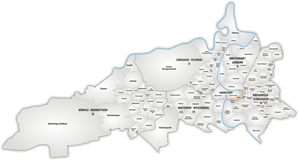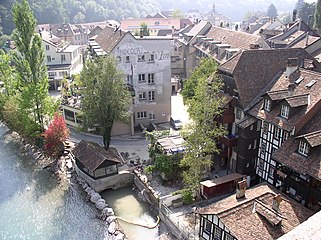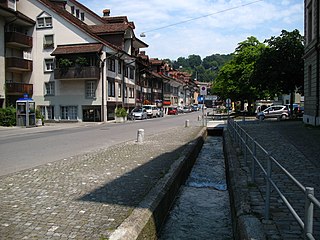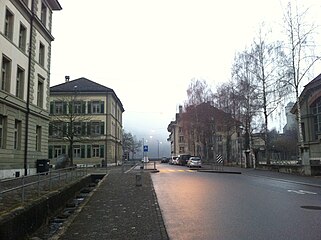Bern-Matte district
|
Schwarzes Quartier Statistical district of Bern |
|
|---|---|
| Coordinates | 601 176 / 199462 |
| height | 496- 526 m |
| surface | 0.137 km² |
| Residents | 1185 (2019) |
| Population density | 8650 inhabitants / km² |
| Proportion of foreigners | 14.1% (2019) |
| Unemployment rate | 1.9% (2016) |
| BFS no. | 351001 |
| Post Code | 3011 |
| district | Inner City (Bern) |
|
Matte (quartier) Common quarters in Bern |
|
|---|---|
| Quarter number | 101 |
| Statistical district | Black quarters |
| district | Inner City (Bern) |
The Matte district (short mat , Bernese German : Mättu , including: Black Quarter ) is part of the old town of Bern . It is also the Statistical District 1 (referred to there as the Black Quarter) and a common district (referred to there as Matte) in District I of the Inner City . The quarter is located on a peninsula in the Aare below the actual old town, directly on the river bank. Geographically and topographically, it is clearly separated from the rest of the city.
The division and color names go back to the year 1798, when Napoleon's troops divided the city into differently colored quarters for better orientation because there were no street names or the majority of the soldiers were illiterate. That is why bilingual signs were made in the appropriate colors and these names and colors for signs are still used today.
In 2019, 1185 inhabitants are reported, of which 1018 are Swiss and 167 are foreigners.
history
The mat is first documented around 1327. It was used to designate the area around the Untertorbrücke , which for a long time was the only crossing of the Aare. The mat formed the landing stage for boatmen and raftsmen . Fishermen and carters worked here , and the Aare's hydropower was used by trade and small industries. The water also attracted tanneries . The mat belonged to the Metzgern district, one of the four Venner districts of the city of Bern. Ecclesiastically, the mat belonged to the parish of Bern. When this was divided into three parts in 1721, the mat came to the newly founded parish of Nydegg. Their parish church is the Nydeggkirche . In 1448 around 600 people lived in the mat, which at that time made up around 10% of the city's population. Several Anabaptists were drowned in the Aare here in the 16th century . When the French introduced the five colored city quarters in 1798, the mat was given the color black.
For a long time, the Matte district was known for its bathhouses , some of which were run by brothels . In 1760 Giacomo Casanova enjoyed himself here , and in the summer of 1824 the immorality that was displayed shook the Berlin architect Karl Friedrich Schinkel .
The first Bernese power station was built here in 1891 . An electric passenger elevator , the Mattelift , has been connecting the mat with the cathedral platform since 1897 . The back of the Bern Minster can be reached on foot from the mat via the 183 wooden steps of the 14th-century mat staircase .
From an industrial and workers' quarter, the mat was gentrified into the home of artists and students in the second half of the 20th century . Expensive renovations of the old houses drove out the traditional trade in favor of service companies, e.g. B. Advertising agencies. Today around 1400 people live in the quarter.
During the floods in the foothills of the Alps in 2005 , four times the normal amount of water flowed through the Aare river bed. As a result, the Matte Quarter was partially flooded several meters. On August 24, 2005, the quarter had to be evacuated. The residents were only able to return to their homes after a few days.
Mat English
In the Matte Quarter , Matten English , a boy's or secret language that was passed on from father to son, developed among young men . Mat English is hardly spoken any more today, only a few expressions have survived in everyday language.
Impressions
View of the mat from the Nydeggbrücke
literature
- Manuel Kehrli (ed.): Light and air. Non-profit building cooperative Bern on the occasion of its 100th anniversary 1911–2011. Bern 2011.
- Beno Stirnemann: Matte English. History of the mat, dialect and secret language. Bern 1994.
- Rosmarie Bernasconi, Der weisse Elefant, Mattengeschichten, published in 2005 by Verlag Einfachlesen
- Hans Markus Tschirren, Stories from the mat, old Mätteler tell by Hans Markus Tschirren, published by Werd Weber Verlag, 2018
Web links
- Homepage for the Matte district
- How the mat became out of a poor neighborhood on www.derbund.ch (accessed on August 14, 2012).
Individual evidence
- ↑ Interactive city map of the city of Bern (selection under "Topics")
- ↑ Bern's colored street signs. The clever solution on altstadt.be
- ↑ Resident population 2019 (PDF, 4.3 MB) City of Bern, March 2020, p. 14 , accessed on March 29, 2020 .
- ↑ The Art Monuments of the Canton of Bern; The City of Bern Volume 1 Page 4
- ↑ The Art Monuments of the Canton of Bern; The City of Bern Volume I, pp. 4–5.
- ^ INSA , p. 249.
- ↑ Beat Siebenhaar , Linguistic Varieties in the City of Bern and what the speakers think of it, in: Germanistik in der Schweiz. Online journal of the Swiss Academic Society for German Studies 1 (2002): (PDF)









